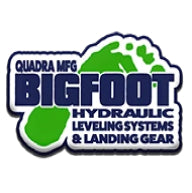Article Content
Even though they are vital to setting up, sometimes tongue jacks can be forgotten when it comes to RV leveling considerations. Before we get into why you want to think about your tongue jack a bit as an RVer, let’s first define what we’re talking about!
The tongue jack is located at the front end of the trailer or camper. It is specifically designed to make it easier for you to attach and detach the RV from your towing vehicle by raising and lowering the front part of the rig.
Tongue Jack Basics
Here's how tongue jacks work when it comes to setting up, leveling, and stabilization:
- Lifting and lowering: The tongue jack consists of a long, adjustable arm with a foot or a pad at the bottom. To lift the RV, you rotate a handle or use an electric motor (depending on the type of jack) to extend the arm, which raises the front end of the RV off the ground. This lifting action allows you to level the RV or attach it to the towing vehicle.
- Support and stabilization: Once the RV is lifted, the tongue jack provides stability and support to the front end. It helps to distribute the weight of the RV and prevents it from tilting or swaying when parked or during transit. This is important for ensuring a safe and secure towing experience.
- Maneuverability: In addition to lifting and supporting, the tongue jack allows you to maneuver the RV while it is not attached to the towing vehicle. By lowering the tongue jack, you can lower the front end of the RV lower to the ground. This may allow you to move the RV around, align it with your campsite, or adjust its position as needed.
- Leveling: Another useful feature of the tongue jack is its ability to help you level the RV. By extending or retracting the jack, you can adjust the height of the front end to ensure that the RV is level when parked. This is important for the proper operation of appliances, stability, and general comfort inside the RV.
Overall, the tongue jack is a handy device that makes it easier for you to hitch and unhitch your RV from the towing vehicle, provides stability and support, aids in maneuverability, and assists in leveling the RV when parked. It's an essential tool for RV owners to ensure a smooth and hassle-free experience while using their rig.
Some tongue jacks come equipped with a foot, while others are simply a post straight from the factory. If you are a passionate RVer, we’d highly recommend adding a foot to your setup if it doesn’t come with one, because it will make setting up and parking your rig easier over time.
In addition, if you own a larger travel trailer, you may want to consider upgrading to an electric “power” tongue jack, which will come pre-equipped with a foot. Instead of a manual hand crank operation, power tongue jacks are push button, meaning less work and hassle to raise and lower.
Read More --> What is the best tongue jack?
SnapPads + Tongue Jacks
Did you know we offer SnapPads for tongue jacks as well? Like the metal feet on your stabilizer system, SnapPads offer greater stability, support, and protection than the jack foot alone.
Like everything else in RVing, though, there isn’t just a single tongue jack shape or size. That’s why we offer multiple SnapPad options for many of the common tongue jack feet on the market today.
If your travel trailer is equipped with the following, we have a SnapPad for it!
- Lippert, Husky, Stromberg w/ a 5.5” round foot - Mini 5.5 round single:
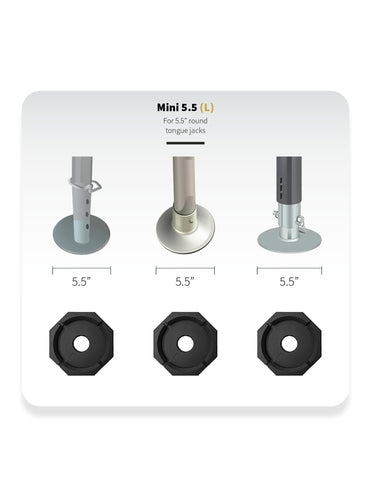
- BAL, Ultra Fab, FIC w/ 5 ⅞”-6” round foot - Mini 6 round single:
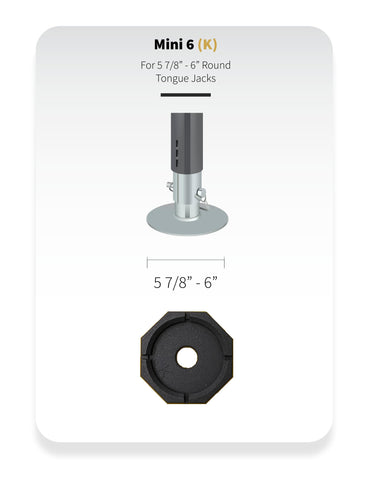
- Lippert power jack with a 9” round foot - XTRA single:
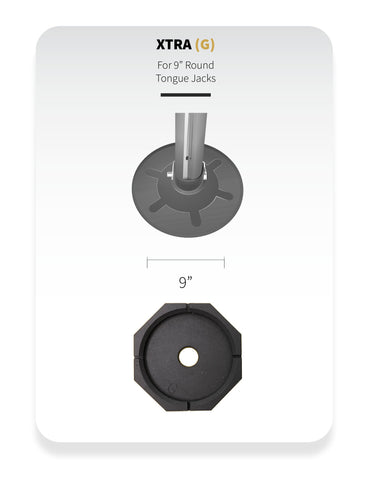
- Rieco Titan 5 ¾” round foot - Mini Square 5 single
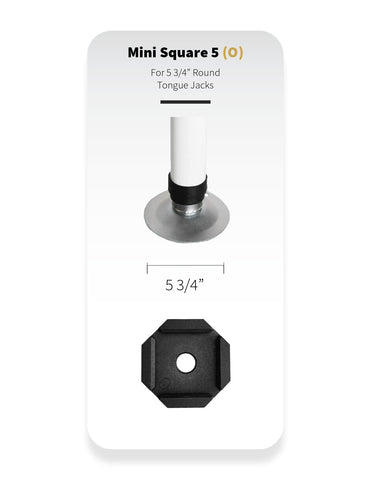
Check out our SnapPad lineup for tongue jacks --> Mini Singles Collection
How to find the right SnapPad for your Tongue Jack
Keep in mind that there is no list of standard tongue jack types or sizes when it comes to RVs. The factory foot size and shape can change year to year or even between models of the same RV brand. In addition, many RVers choose to upgrade their tongue jack by adding a different foot or moving to a power system.
As a result, the only way to be 100% sure about which SnapPad you need for your tongue jack is to physically measure the foot. And because SnapPads are designed to fit snugly on your metal feet, the difference of just ¼ of an inch can separate a good fit from a bad one.
When measuring, it is important to raise your tongue jack off the ground and measure the diameter of the jack foot from the bottom, not across the top.
Like this:
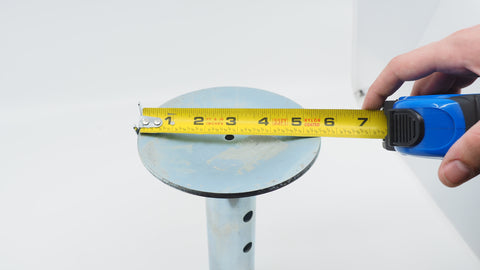
Not this: 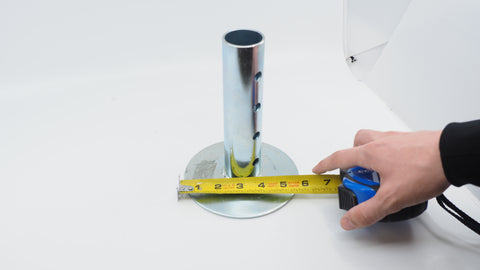
Why? As you can see, the metal post gets in the way of taking an accurate measurement of the foot’s diameter. As noted, there only needs to be a small mistake in your measurement to throw off your SnapPad compatibility.
Need some help?
Still not sure? Please contact us directly if you have any questions about SnapPads for your tongue jacks or your leveling setup. Our customer service team are all experts when it comes to SnapPad compatibility, measuring, and installation.
Call us at +1 866-923-9538, email us at info@rvsnappad.com, or chat directly with us on our site.
Summary
- Tongue Jacks are a vital piece of your stabilizing and leveling setup. Your tongue jack should always be equipped with a metal foot to help in the operation and stabilization of your rig.
- Owners of bigger travel trailers should seriously consider upgrading to a power/electric tongue jack for ease of use.
- Adding a SnapPad to your tongue jack can improve the stability and safety of your setup. It also adds grip and protection for situations where you park on slopes or prepared surfaces like concrete or asphalt.
- The size and shape of tongue jack feet can vary randomly from RV to RV. The best way to ensure the proper fit for your rig is to measure your foot and then match it to the correct SnapPad







